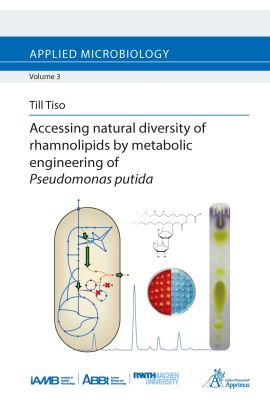The petrochemical industry is essential for many consumer goods currently in use. Implementing innovative biobased processes, renewable resources are used as substitutes for crude oil in goods such as household detergents, producing bioderived cleaning agents. However, biosurfactants are still expensive compared to their chemically synthesized counterparts. In this work, the exploitation of Pseudomonas putida for the heterologous synthesis of rhamnolipids was the main focus. Rhamnolipids are glycolipids that have a high potential for industrial applications. However, the production of rhamnolipids using the wild-type producer Pseudomonas aeruginosa entails a number of significant limitations, as P. aeruginosa is a human pathogen, and purification is expensive because rhamnolipid production by P. aeruginosa requires plant oils as a carbon and energy source.
Introducing rhamnolipid synthesis genes into P. putida enabled the first microbial cell factory for the production of rhamnolipids from glucose. The synthesis of these secondary metabolites was uncoupled from growth and circumvented sophisticated fermentation procedures. A closer look at the underlying metabolic network during rhamnolipid synthesis revealed that P. putida upregulated its central carbon metabolism in order to meet the created demand. This finding was exploited as a metabolic engineering strategy and led to the development of a high-producing strain featuring a 3 g/L titer and a 40% carbon yield.
Subsequently, we focused on the enhancement of transcriptional activity by introducing synthetic promoter libraries. This approach was successful, and a wide range of rhamnolipid productivity was achieved; however, the high flux towards the product was unstable in the long run.
After establishing rhamnolipid production, we focused on the diversification of the product spectrum. Initially, only mono-rhamnolipids were synthesized. By introducing and eliminating specific genes in the rhamnolipid biosynthesis pathway, we were also able to produce di-rhamnolipids and the rhamnolipid precursor, hydroxyalkanoyloxy alkanoic acid.
Lastly, we streamlined the host metabolism and optimized the fermentation conditions, including medium composition. The highest titer was achieved in a fed-batch flask experiment in which 7 g/L of surfactants were produced.
The results are discussed in the context of rational strain engineering for the production of designer surfactants.
| Autor | Tiso, Till |
|---|---|
| Lieferzeit | 3-4 Tage |
| Gewicht | 0.35 kg |
| Erscheinungsdatum | 01.09.2016 |
Applied Microbiology
Accessing natural diversity of rhamnolipids by metabolic engineering of Pseudomonas putida
Kurzbeschreibung
The petrochemical industry is essential for many consumer goods currently in use. To implement innovative biobased processes, renewable resources are used as substitutes for crude oil in goods such as cleaning agents. However, biosurfactants are still expensive compared to their chemically synthesized counterparts. In this work, the exploitation of Pseudomonas putida for the heterologous synthesis of rhamnolipids, glycolipids with a high potential for industrial applications was the main focus.

